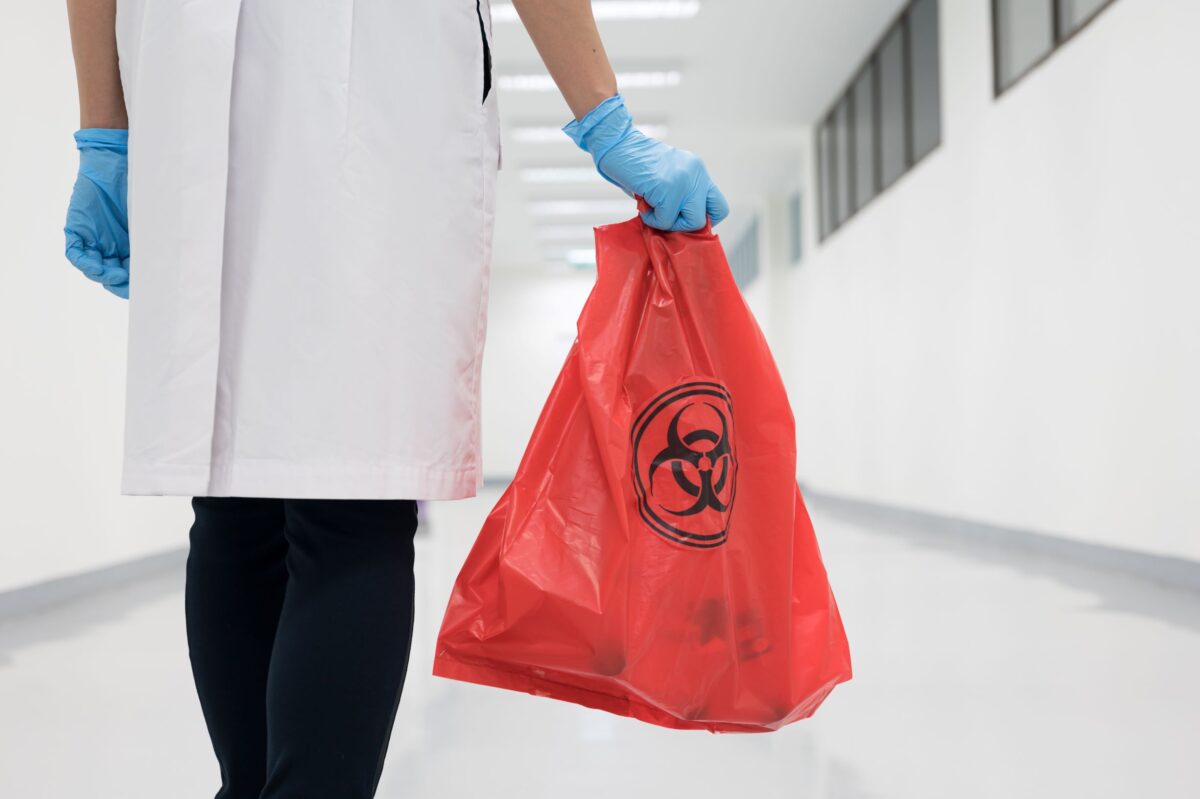How to Dispose of Biohazard Waste

This time on the BIOClean Team blog we’re taking a step back to the big picture of what we do. We clean hazardous environments, we disinfect dangerous situations, we handle the biohazardous waste that others cannot. Here’s how to dispose of biohazard waste as a professional!
TO BE CLEAR: If you’re not a trained professional, cleaning up biohazardous waste can be dangerous! If you have a dangerous, biohazard situation call the professionals, call the BIOClean Team!
Alright, with that out of the way we can talk, broadly, about how we dispose of biohazard waste.
When people think of biohazard waste, they almost assuredly think of the red ‘trash’ bags that biohazard waste is put into. Let’s talk about that.
Biohazard Waste Bags
There are waste bags that are specifically designed to handle biohazards. These waste bags are usually red with bold lettering marking them: BIOHAZARD. This standard helps anyone who might come across the waste down the line know to handle it with care. These bags are for any liquid or solid medical waste, anything contaminated with blood or other potentially infectious material.
What Constitutes “Other Potentially Infectious Material”
Good question, that ‘other’ opens up a lot of possibilities. Any sort of body fluids or things contaminated by body fluids falls into this infectious material category. Bodily fluids including things like: semen, vaginal secretions, synovial, cerebrospinal, pleura, amniotic, or pericardial fluid. Anything that is visibly contaminated with blood as well counts as potentially infectious material. There are a lot of things that are a biohazard and need to be handled with care.
How to Use Biohazard Waste Bags for Disposal
When using biohazard waste bags follow these quick and clear points:
Inspect the bag and check it’s integrity. The last thing anyone wants is to fill a biohazard waste bag only to have it split apart on them.
Sharps go in sharps containers first. If the biohazard waste and potentially infectious material include any “sharps” these to go into a sharps container first, a hard-shelled container that will prevent punctures. Sharps are any sort of medical device designed to lacerate or puncture the skin.
Separate and level the materials. Before loading up the waste bags, do your best to fill it evenly.
Seal the bag, immediately after removing it from the bin or container.
All the gear, all the time. When handling red biohazard bags use protective equipment including gloves, apron, face mask, and eye protection.
What Can’t Go In Biohazard Waste Bags?
These waste bags are designed for specific things so anything that isn’t biohazard or other potentially infections material should be kept away. Specifically, do not place any of these in biohazard waste bags:
- Chemicals including:
- corrosives
- Formaldehyde
- Solvents
- waste oils
- alcohols
- Radioactive waste
- Human remains
- Pharmaceutical waste
- Chemotherapy waste
- Materials containing lead
- Hazardous waste including:
- batteries
- light bulbs
- heavy metals
- compressed gas cylinders
- aerosol cans
- inhalers
- Uncontaminated solid waste including beverage containers and food wrappers
- Empty IV tubing without any visible blood present
- Sphygmomanometers, glass thermometers, and any other device that contains mercury
- Mercury-containing dental wastes including contact and non-contact amalgam products, vacuum pump filters, amalgam sludge, chairside traps, empty amalgam capsules, and extracted teeth with mercury filling
Hopefully, that helped illuminate what goes into the handling of biohazard waste bags as well as what can and can’t go in them. It’s worth repeating that if you are put in a situation where you have to handle biohazard waste and you have not been properly trained on it you should not handle the waste at all!
In that scenario, you need to call the professionals. Call the BIOClean Team today, for all your biohazard cleanup needs!
